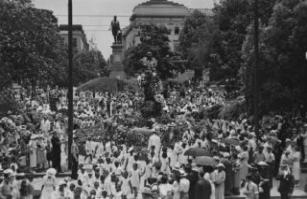
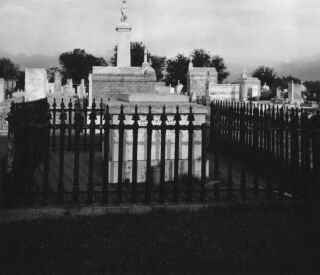
| McDonogh Day |
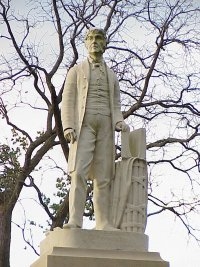
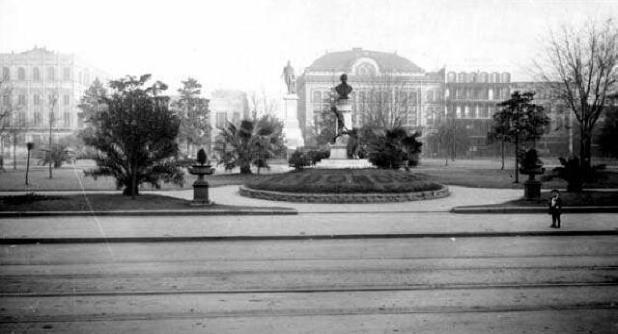
| When millionaire merchant John McDonogh died in 1850, he left his fortune to be divided equally between his native city of Baltimore, MD and his adopted city of New Orleans, specifically for the purpose of creating public schools for the education of the poor of all castes and races. The money was used to build more than thirty schools in New Orleans. |
| The photo below was taken just after the monument was erected in 1898. Henry Clay's statue can be seen in the background; the building to the left was Odd Fellow's Hall and the building just to the right of the Clay statue was St. Patrick's Hall, once used as the first home of the New Orleans Public Library. |
| The statue honoring John McDonogh in Baltimore, MD, where they still hold ceremonies every year in his memory at a school which bears his name. |
| A photo of McDonogh's tomb in the McDonoghville Cemetery, Gretna, near his New Orleans home. His remains were moved to Baltimore in 1860. |
| Below and right, McDonogh Day in 1937. |
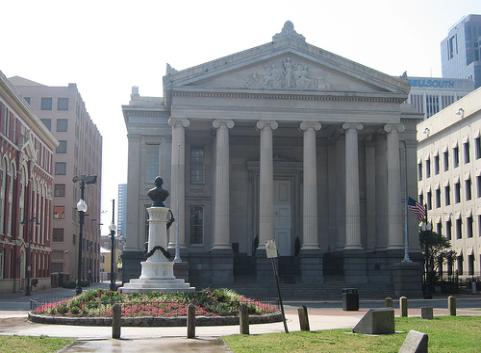
| Abstracts from the Memoranda by John McDonogh to the Executors of his Estate The Plan which my mind formed (influenced, I trust by the Divine Spirit) and has pursued for nearly Forty Years, to accumulate and get together a large Estate, in lands, lots of ground, in and near the City, Houses, etc., for the Education of the Poor, will in time, I doubt not, yield a revenue sufficient to educate all the Poor of the two States of Louisiana and Maryland. To effect and secure that I have laid its Foundations deep and broad, in and all around the City of New Orleans in every direction, so that for centuries to come (if managed in wisdom), its Revenue must and will go on increasing in amount with the growth and extention of the City (which is destined to be one of the greatest in extent and population the world has ever seen), until its Rents shall amount to some millions of dollars annually. If, therefore, those who will come after me and will have the management of this store (which I have striven to amass and pile up)will labor to increase and render it productive with the same fidelity which I have husbanded it and striven to make it a great one, then, indeed, it will become in time a huge mountain of wealth, and will yield its increase to the Honor of God and the benefit of Generations. yet unborn, through all Ages of the World. In relation to man's happiness, constituted as he is, I have always been convinced that the intellectual cultivation of the Youth of our Country ALONE, without religious cultivation, cannot secure it or give permanency to the Free institutions of the Country, as they now exist. Education, separated from Religion yields no security to morality and Freedom. I trust, I pray, that the mode I have adopted to effectuate it will receive the Divine Blessing. I have, notwithstanding, much, very much, to complain of the World, rich as well as poor. It has harassed me in a thousand different ways. Great injustices have been instituted and carried on against me, to deprive and take from me property honestly acquired (for I have none, nor would have any that was not acquired by honest industry and the sweat of my brow), and when obliged to seek justice through Courts of Law (after waiting years and years with those who were indebted to me, and refused payment), it has often been refused me. Many and many times, have juries of my fellow men given me a stone when I asked them for bread. They said of me, he is rich, old, without wife or child, let us take from him then what he has. Infatuated men, they knew not that was an attempt to take from themselves, for I was laboring, and had labored all my life, not for myself, but for them and their children. Their attempts, however, made me not to swerve, either to the right hand or to the left. I persevered an onward course, determined to do them good, whether they would have it, or whether they would not have it. And I have so striven, so labored to the last. The result is in the hands of Him who fixes and determines all results. He will do therewith as seemeth good unto Himself. Signed: John McDonogh |
| The link to this page is: http://old-new-orleans.com/NO_McDonogh_Day.html Back to Old New Orleans Whispers - Home |
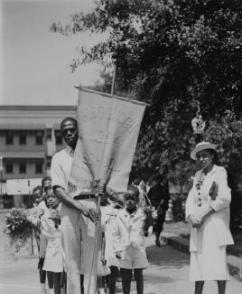
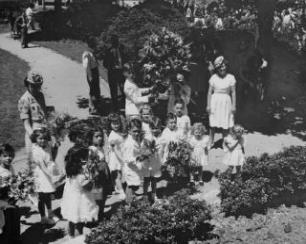
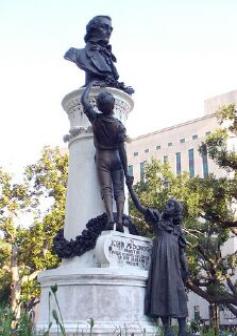
| Initially, the public school children of the city gathered at John McDonogh's gravesite across the river in Gretna, and placed flowers on his grave to show their gratitude for his bequest on their behalf. In 1860, his remains were moved by his family to Baltimore, but still the children gathered at the cemetery every year. Finally, a fund was started to build a monument to him. For six years, the children of New Orleans saved their pennies to build a monument (pictured above and below) to John McDonogh. The monument, dedicated in 1898, stands in Lafayette Square and faces Gallier Hall (above), which was used by New Orleans as its City Hall until 1958. Because the funds were raised by the children, it reads: "To John McDonogh from the Public School Children of New Orleans, 1892 - 1898." From 1898 until the 1950's, the children of New Orleans gathered at this monument every year in May...the girls in their Sunday-best white dresses and the boys in starched white shirts; they brought flowers to leave at the monument, bands played, speeches were made and the "Ode to McDonogh" was sung. When the new City Hall was constructed in 1958, another statue of John McDonald, who was generally referred to as "the father of New Orleans public schools," was erected across from the new building in Duncan Plaza. However, as time went on, the tradition began to have fewer schools participanting and, through the years, the names of most of the McDonogh Schools were changed. As I write this, only a handful of schools still bear McDonogh's name and just one school, the McDonogh School across the river in Gretna, near the site of his home, still commemorates the occasion. John McDonogh was controversial in life and controversy has followed him since his death. The fact that he was a slave owner has caused many to question whether there should be monuments to him at all. Others feel that, since his gift to the cities of New Orleans and Baltimore helped educate children of all races for many years, the monuments are appropriate. I chronicle a bit of John McDonogh's history on this page because his schools, his monuments and John McDonogh Day itself are woven into the fabric of the lives of more than one generation of New Orleanians. They are part of our history. Is it appropriate to remember him or honor him with monuments? I leave that to the present generation to decide and, whatever they choose, I will be content with their decision. |